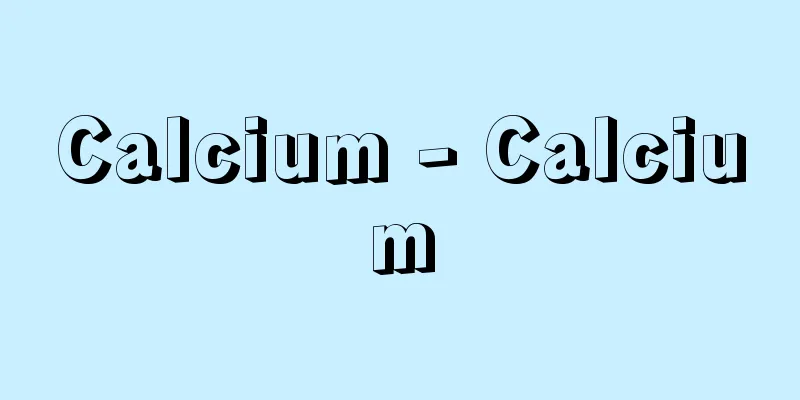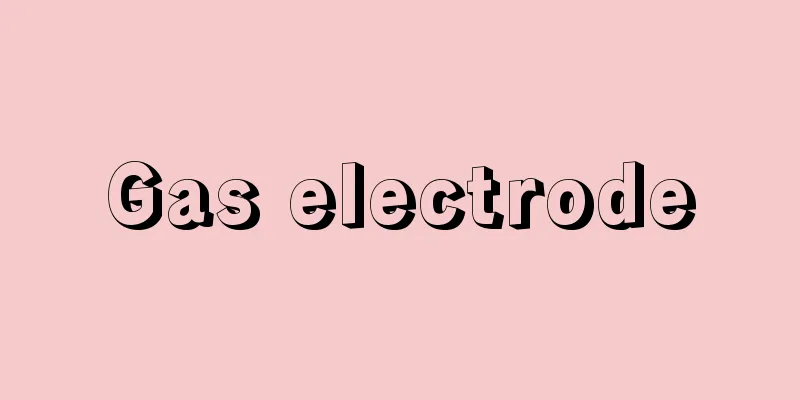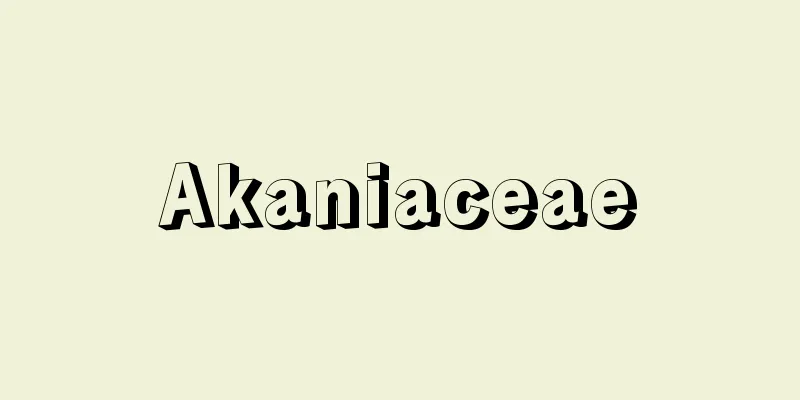Calcium - Calcium

|
It belongs to group 2 of the periodic table and is one of the alkaline earth metal elements. historyAlthough it was only a hundred years ago that the metals were discovered as simple metals, they have been used as compounds for a long time. It seems that humans were already familiar with limestone (calcium carbonate) when they first began to use fire, and obtained lime (calcium oxide, called calx in Latin, from which the word calcium comes) by thermal decomposition. In ancient times, slaked lime (calcium hydroxide, made by adding water to lime) was used as a mortar to bond stones and bricks, and records from the 1st century show that gypsum (calcium sulfate) was used for a similar purpose. Marble (calcium carbonate) was also known for a long time, and is used to this day as a material for buildings, monuments, and statues. The ancients considered the oxides of alkaline earth metals to be a kind of "earth". Even at the end of the 18th century, the scientific methods of the time were not able to break down this "earth" into its simpler components. The Frenchman Lavoisier also classified calcium oxide, strontium oxide, barium oxide, etc. as elements in his book Traité élémentaire de chimie (The Elements of Chemistry) written in 1789. In 1808, the Englishman Davy isolated metallic potassium for the first time by electrolyzing a mixture of calcium oxide and mercury(II) oxide moistened with water. Later, in 1855, the Frenchman Moissan invented a method of producing metallic potassium by electrolysis of molten calcium chloride. [Torii Yasuo] ExistenceCalcium is an extremely reactive element, so it cannot exist in nature as a metal, but forms compounds as a divalent cation. Its abundance in the Earth's crust is third only to oxygen, silicon, aluminum, and iron. The Earth's crust is mainly composed of silicate and aluminosilicate minerals, of which calcium is an important component. Over billions of years throughout the Earth's long geological era, silicate minerals have been destroyed by the action of carbon dioxide and moisture in the atmosphere, geothermal heat, etc., and the calcium contained in them was washed out as carbonates and sulfates, and deposited as limestone and gypsum. Calcium carbonate is extremely difficult to dissolve in water, but if the water contains carbon dioxide, its solubility increases because it is converted into water-soluble calcium bicarbonate by the following reaction: CaCO 3 +CO 2 +H 2 OCa(HCO 3 ) 2 Calcium is also present in animals and plays an important role in life activities. The shells of many lower animals, such as shellfish, are made of calcium carbonate, while the main component of the skeletons of higher animals, such as humans, is calcium phosphate. [Torii Yasuo] Manufacturing methodIndustrially, calcium carbonate is mainly produced by the molten salt electrolysis method and the thermal reduction method. In the electrolysis method, anhydrous calcium chloride is used as the raw material, and calcium fluoride or potassium chloride is mixed with it to lower the melting point, and electrolysis is carried out at about 800 °C. A steel electrolytic cell lined with graphite is used as the positive electrode, and a water-cooled iron electrode is used as the negative electrode. In the thermal reduction method, lime obtained by burning high-purity limestone is used as the raw material, and this is reduced with aluminum. 6CaO+2Al―→3Ca+Ca 3 Al 2 O 6 [Torii Yasuo] natureIt is a silver-white metal, and new surfaces have a metallic luster. Its crystals have a face-centered cubic structure below 300°C, but there are several other crystal modifications, such as a hexagonal close-packed structure above 450°C. It is the second lightest metal after the alkali metals, and although it is not as soft as barium or lead, it has some ductility. It shows an orange-red flame reaction. Its chemical properties are similar to those of its congeners strontium and barium, and it forms compounds with similar properties and structures, but in general, its reactivity decreases slightly in the order Ba > Sr > Ca. At room temperature, it slowly reacts with oxygen, nitrogen, and water in the air, so its surface is covered with a yellow-gray coating of oxides, nitrides, and hydroxides. When heated in oxygen (or air), it catches fire and burns, becoming the oxide CaO, but unlike alkali metals below potassium, it does not form peroxides or superoxides. When heated in pure nitrogen, it forms the nitride Ca 3 N 2. It slowly reacts with hydrogen at 400°C or higher to form calcium hydride, but if the hydrogen pressure is high, it will react at even lower temperatures. It also reacts with halogens, phosphorus, sulfur, and selenium at high temperatures, and directly with carbon, silicon, and boron. It reacts slowly with cold water and violently with hot water, generating hydrogen and leaving behind hydroxides. It reacts slowly with alcohols and violently with acids, generating hydrogen and simultaneously producing an alkoxide (a compound in which the hydrogen of the hydroxyl group of alcohols is replaced with a metal; also known as an alcoholate) or a salt. It dissolves in liquid ammonia to give a deep blue solution (colored by solvated electrons), but when the ammonia is evaporated, the hexaammine calcium complex [Ca(NH 3 ) 6 ] remains. When heated in gaseous ammonia, the following reaction occurs: 6Ca+2NH 3 ―→3CaH 2 +Ca 3 N 2 Calcium compounds are very similar to strontium and barium compounds, but their solubility in water is generally somewhat greater, with a few exceptions. [Torii Yasuo] ApplicationsDue to its strong reducing power, metallic calcium is used to produce metals from oxides and halides of difficult-to-reduc metals such as vanadium, titanium, zirconium, thorium, and uranium. It also has a relatively high melting point and is difficult to evaporate, so it is used as a deoxidizer and desulfurizer for molten iron, steel, and other metals and alloys. When activated with sodium, it easily combines with nitrogen, so it is used to refine rare gases such as argon and helium. It is also used as an additive to alloys, and has various applications as an alloy with lead, aluminum, magnesium, etc. Other uses include as a reducing agent in organic synthesis, as an agent to remove bismuth from lead, and as a raw material for producing calcium hydride. [Torii Yasuo] Calcium and the human bodyCalcium is one of the important minerals in the human body, and is the largest mineral contained in the human body, at about 1.2 kilograms. 99% of calcium is found in bones and teeth, with the remainder in blood and muscles. Calcium in bones and teeth becomes calcium phosphate, which forms hard tissues. Bones act as the support of the human body and also act as a calcium storage facility; when blood calcium levels are low, calcium is extracted from the bones to replenish the blood, and excess calcium is returned to the bones. Most of the calcium in blood is present in serum, where it is always maintained at a nearly constant level. Most of the serum calcium is ionized and is involved in various physiological functions. It also plays an important role in blood coagulation. Calcium is also involved in myocardial contraction, muscle movement, nerve impulse transmission, cell division, and has other important physiological functions, such as promoting the phagocytosis of white blood cells and increasing resistance to diseases. Calcium in blood also plays an important role in maintaining the hydrogen ion concentration index (pH) of body fluids. Calcium is primarily absorbed from the intestines, and excreted both through urine and the intestines. Phosphorus and vitamin D are particularly needed for absorption, and absorption is best when the ratio of calcium to phosphorus is roughly 1:1. If the ratio of phosphorus becomes extremely high, calcium absorption is hindered, which can lead to calcium deficiency. Calcium deficiency conditions include rickets, osteomalacia, and osteoporosis, while calcium excess conditions include kidney stones and chondrofibrocalcification. Foods that are high in calcium include milk and dairy products, seaweed, leafy vegetables, beans, and small fish bones. The daily intake standard varies by age and sex, but adults need about 600 milligrams, and during the growth period, 1.3 to 1.5 times that of adults. In addition, pregnant and lactating women need calcium in the fetus and in breast milk, so it is important to take a little more to avoid deficiency. Nutrition surveys of Japanese people have shown insufficient intake for many years, and this has become an important point in dietary guidance. On the other hand, health problems caused by excessive intake from supplements and processed foods with additives are becoming a problem. In order to reduce the risk, the Ministry of Health, Labor and Welfare has established the "Dietary Reference Intakes for Japanese People," which shows the upper limit as well as the approximate and target amounts to be taken from food. [Tomomi Kono and Yonago Yamaguchi] "The New Medicine of Calcium, revised edition, by Katase Tan (1990, Ningen Igakusha)" ▽ "Handbook of Bone and Calcium Testing, edited by Morii Hiroyo (1996, Nakayama Shoten)" ▽ "Calcium and Bones, edited by Nishii Yasuho, Morii Hiroyo, Ezawa Ikuko, and Kojima Itaru (2001, Asakura Shoten)" ▽ "Dictionary of Minerals, edited by Itokawa Yoshinori (2003, Asakura Shoten)" ▽ "Japanese Dietary Reference Intakes 2015 Edition - Report of the Ministry of Health, Labor and Welfare's "Japanese Dietary Reference Intakes" Formulation Review Committee" edited by Hishida Akira and Sasaki Satoshi (2014, Daiichi Publishing)" ▽ "The New Wonders of Calcium - Calcium Supporting the Future of Humanity, by Fujita Takuo (Kodansha, Bluebacks)" [References] | | | | | | | | | | | | | | |Mortar| | | | [Supplementary information] |©Shogakukan "> Periodic Table Source: Shogakukan Encyclopedia Nipponica About Encyclopedia Nipponica Information | Legend |
|
周期表第2族に属し、アルカリ土類金属元素の一つ。 歴史金属単体として得られたのはいまから百数十年前であるが、化合物としてはずっと昔から利用されていた。人類は火を使用するようになった時期に、すでに石灰岩(炭酸カルシウム)を知り、その熱分解によって石灰(酸化カルシウムのこと、ラテン語でcalxという。カルシウムの語源はこれに由来する)を得ていたようである。古代において、消石灰(水酸化カルシウムのこと。石灰に水を加えたもの)はモルタルとして石やれんがの接合剤に用いられ、また同様の目的のために石膏(せっこう)(硫酸カルシウム)が使用されたことは1世紀の記録に残っている。大理石(炭酸カルシウム)も以前から知られており、建物、記念碑、彫像の材料として今日まで用いられている。古代の人々はアルカリ土類金属の酸化物を一種の「土」と考えていた。18世紀の終わりごろになっても、当時の科学の方法ではこの「土」をもっと簡単な成分に分解することはできなかった。フランスのラボアジエも1789年に書いた著書『Traité élémentaire de chimie』(『化学原論』)のなかで、酸化カルシウム、酸化ストロンチウム、酸化バリウムなどを元素として分類している。1808年にイギリスのデービーは、水で湿らせた酸化カルシウムと酸化水銀(Ⅱ)との混合物を電解することによって、初めて金属カリウムを単離している。その後1855年に、融解塩化カルシウムの電解による製法がフランスのモアッサンによって考案された。 [鳥居泰男] 存在カルシウムはきわめて反応しやすい元素であるから、自然界に金属単体として存在できず、2価陽イオンとして化合物をつくっている。元素の地殻中の存在度は、酸素、ケイ素、アルミニウム、鉄に次ぐ大きさである。地殻はケイ酸塩やアルミノケイ酸塩鉱物が主体となって構成されているが、カルシウムがその重要な一成分となっているからである。ケイ酸塩鉱物は、地球の長い地質時代を通じて何十億年という年月の間に、大気中の二酸化炭素や水分、地熱などの作用により破壊され、含まれていたカルシウム分は炭酸塩や硫酸塩となって流出し、石灰石や石膏として堆積(たいせき)した。炭酸カルシウムはきわめて水に溶けにくいが、水が二酸化炭素を含んでいると、次の反応によって水溶性の炭酸水素カルシウムに変わるため、その溶解度は大きくなる。 CaCO3+CO2+H2OCa(HCO3)2 カルシウムは動物体内にも存在し、生命の活動に重要な役割を果たしている。貝類など多くの下等動物の殻は炭酸カルシウムでできており、人間など高等動物の骨格の主成分はリン酸カルシウムである。 [鳥居泰男] 製法工業的には、主として融解塩電解法と熱還元法によって製造される。電解法では無水塩化カルシウムを原料とし、これにフッ化カルシウムまたは塩化カリウムを混ぜて融点を下げ、約800℃で電解が行われる。黒鉛で内張りした鋼鉄製電解槽を用いてこれを正極とし、水冷式鉄電極を負極とする。熱還元法では、高純度の石灰石を焼いて得た石灰を原料とし、これをアルミニウムで還元する。 6CaO+2Al―→3Ca+Ca3Al2O6 [鳥居泰男] 性質銀白色の金属で、新しい表面は金属光沢を呈する。その結晶は300℃以下では面心立方構造をとるが、このほかいくつかの結晶変態があり、たとえば450℃以上では六方最密充填(じゅうてん)構造をとる。アルカリ金属に次いで軽く、軟らかさの点ではバリウムや鉛ほどではないが、いくぶんかの展延性をもっている。橙赤(とうせき)色の炎色反応を示す。 同族のストロンチウム、バリウムによく似た化学的性質を示し、性質や構造の類似した化合物をつくるが、一般に反応活性の点ではBa>Sr>Caの順にわずかながら低下している。常温において空気中の酸素、窒素および水と徐々に反応するので、表面が酸化物、窒化物および水酸化物からなる黄灰色の被膜で覆われる。酸素中(または空気中)で加熱すると火を発して燃え、酸化物CaOとなるが、カリウム以下のアルカリ金属のように、過酸化物や超酸化物を生ずることはない。純窒素中で加熱すれば窒化物Ca3N2を生ずる。水素とは400℃以上で徐々に反応して水素化カルシウムとなるが、水素圧が高いとさらに低温でも反応する。このほかハロゲン、リン、硫黄(いおう)、セレンと高温で反応し、炭素、ケイ素、ホウ素とも直接反応する。冷水とは徐々に、温水とは激しく反応して水素を発生し、あとに水酸化物を残す。アルコールとはゆっくりと、また酸とは激しく反応し、水素の発生と同時にアルコキシド(アルコール類のヒドロキシ基の水素を金属で置換した化合物。アルコラートともいう)または塩を生成する。液体アンモニアに溶けて濃青色(溶媒和電子による発色)の溶液を与えるが、アンモニアを蒸発しさると、あとにヘキサアンミンカルシウム錯体[Ca(NH3)6]が残る。気体アンモニア中で熱すれば次の反応がおこる。 6Ca+2NH3―→3CaH2+Ca3N2 カルシウムの化合物はストロンチウム、バリウムの化合物とよく似ているが、水に対する溶解度は二、三の例外はあるが、一般にやや大きくなっている。 [鳥居泰男] 用途金属カルシウムはその還元力の強い点から、バナジウム、チタン、ジルコニウム、トリウム、ウランなど難還元性金属の酸化物、ハロゲン化物から金属を製造するのに使われる。また比較的融点が高く蒸発しにくいので、融解鉄や鋼、その他の金属や合金の脱酸剤、脱硫剤として用いられる。さらにナトリウムで活性化すると窒素と結合しやすくなるので、アルゴン、ヘリウムなど希ガスの精製に利用される。また合金の添加材としても用いられ、鉛、アルミニウム、マグネシウムなどとの合金として各種の用途がある。そのほか、有機合成における還元剤、鉛からのビスマス除去剤、水素化カルシウムの製造原料などとなる。 [鳥居泰男] 人体とカルシウムカルシウムは人体にとって重要な無機質の一つで、人体に約1.2キログラムと無機質中では最大量含まれている。骨および歯に99%存在し、残りは血液および筋肉に含まれる。骨や歯のカルシウムはリン酸カルシウムとなって硬い組織を構成している。骨は人体の支柱的な役割を果たすとともに、カルシウムの貯蔵庫で、血中カルシウムが少なくなると、骨のなかからカルシウムが出てきて補給し、また余分のカルシウムは骨に戻る。 血液中のカルシウムはほとんどが血清中に存在し、つねにほぼ一定の水準に保たれており、血清カルシウムの多くはイオン化していて、各種の生理作用に関係している。また、血液の凝固性に対しても重要な役割を果たす。カルシウムはまた、心筋の収縮作用、筋肉の運動、神経の刺激伝達、細胞分裂などに関係し、白血球の食菌作用を促して疾病に対する抵抗力を増加するなど、生理的に重要な働きをもつ。また、血中のカルシウムは体液の水素イオン濃度指数(pH)保持にも大きな役割を果たしている。 カルシウムは主として腸内から吸収され、排泄(はいせつ)は尿および腸内の両方から行われる。とくに吸収時にはリンおよびビタミンDが必要とされ、カルシウムとリンの比率がほぼ1対1のときに吸収がよい。極度にリンの比率が大きくなると、カルシウムの吸収は疎外され、それが原因でカルシウム不足を生じることがある。カルシウムの欠乏症には、くる病、骨軟化症、骨粗鬆症(こつそしょうしょう)などが、また、過剰症には腎臓(じんぞう)結石、軟骨繊維石灰化症などがある。 カルシウムを多く含む食品としては、牛乳および乳製品、海藻、葉菜類、豆類、小魚の骨ごとの摂取があげられる。1日の摂取基準は年齢や性別によって異なるが、成人では約600ミリグラム、成長期には成人の1.3~1.5倍が必要である。また、妊婦や授乳婦では、胎児や母乳中にカルシウムが必要なので、不足しないようにやや多めにとることがたいせつである。日本人の栄養調査結果では長年にわたって摂取不足がみられ、食生活指導の重要なポイントになっている。その一方で、サプリメントや添加した加工食品などからの過剰摂取による健康障害が問題視されている。厚生労働省は、そのリスクを下げるために、「日本人の食事摂取基準」を設定し、食事からとるべき目安量や目標量とともに上限量を示している。 [河野友美・山口米子] 『片瀬淡著『新カルシウムの医学』改訂版(1990・人間医学社)』▽『森井浩世編『骨・カルシウム検査ハンドブック』(1996・中山書店)』▽『西井易穂・森井浩世・江沢郁子・小島至編『カルシウムと骨』(2001・朝倉書店)』▽『糸川嘉則編『ミネラルの事典』(2003・朝倉書店)』▽『菱田明・佐々木敏監修『日本人の食事摂取基準2015年版――厚生労働省「日本人の食事摂取基準」策定検討会報告書』(2014・第一出版)』▽『藤田拓男著『新カルシウムの驚異――人類の未来をささえるカルシウム』(講談社・ブルーバックス)』 [参照項目] | | | | | | | | | | | | | | | | | | | [補完資料] |©Shogakukan"> 周期表 出典 小学館 日本大百科全書(ニッポニカ)日本大百科全書(ニッポニカ)について 情報 | 凡例 |
Recommend
Gardner, A.
...These photographs allowed people to become fam...
Heart transplantation
(1) History of heart transplantation The first hum...
Moroni (English spelling)
The capital of the island nation of Comoros, loca...
Chungcheong-do (English spelling)
A region in the midwest of the Korean Peninsula, o...
One Sakai Fisherman
⇒ Goro Soganoya Source: Kodansha Digital Japanese ...
Dolichocebus
...These include Aegyptopithecus of the Cercopith...
Ingojinskoye - Ingojinskoye
...Population: 370,000 (1990). Since 1653 it has ...
Shunparou Notes - Shunparou Notes
A collection of essays written by Shiba Kokan, kno...
Qutadghu Bilig
This book is a moral book for the monarch, written...
Sauce demi-glace (English spelling)
...Add mirepoix (a mixture of aromatic vegetables...
Compulsory referendum - Compulsory referendum
… [Three types] In a referendum system, after the...
Giovanni, P. (English spelling) GiovanniP
…His prose translation of the Odyssey is consider...
Shigarami Zoushi - Shigarami Zoushi
A literary magazine from the Meiji period. It was ...
Malignant pleurisy
(4) Cancerous pleuritis (pleuritis carcinomatosa) ...
Law on the Elimination of Excessive Concentration of Economic Power - Kado Keizairyoku Shuchuu Haijohho
This law was enacted in 1947 (Showa 22) as part o...
![Elburz [Mountain] - Elburz](/upload/images/67cb0bea16c12.webp)








